The Skylake Core i3 (51W) CPU Review: i3-6320, i3-6300 and i3-6100 Tested
by Ian Cutress on August 8, 2016 9:00 AM ESTGrand Theft Auto V
The highly anticipated iteration of the Grand Theft Auto franchise finally hit the shelves on April 14th 2015, with both AMD and NVIDIA in tow to help optimize the title. GTA doesn’t provide graphical presets, but opens up the options to users and extends the boundaries by pushing even the hardest systems to the limit using Rockstar’s Advanced Game Engine. Whether the user is flying high in the mountains with long draw distances or dealing with assorted trash in the city, when cranked up to maximum it creates stunning visuals but hard work for both the CPU and the GPU.
For our test we have scripted a version of the in-game benchmark, relying only on the final part which combines a flight scene along with an in-city drive-by followed by a tanker explosion. We record both the average frame rate and the percentage of frames under 60 FPS (16.6ms).
For this test we used the following settings with our graphics cards:
| Grand Theft Auto Settings | |||
| Resolution | Quality | ||
| Low GPU | Integrated Graphics | 1280x720 | Lowest |
| ASUS R7 240 1GB DDR3 | |||
| Medium GPU | MSI GTX 770 Lightning 2GB | 1920x1080 | Very High |
| MSI R9 285 Gaming 2G | |||
| High GPU | ASUS GTX 980 Strix 4GB | 1920x1080 | Very High |
| MSI R9 290X Gaming 4G | |||
Integrated Graphics
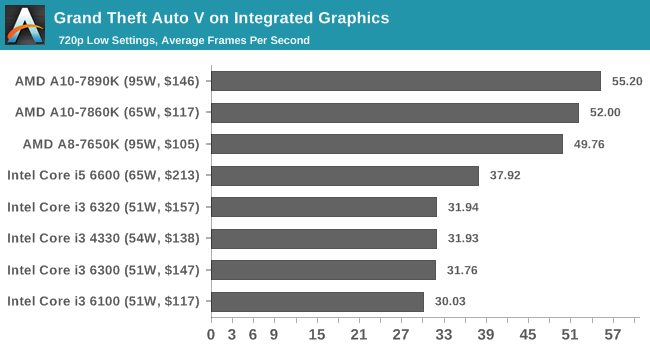
![Grand Theft Auto V on Integrated Graphics [Under 60 FPS]](https://images.anandtech.com/graphs/graph10543/83071.png)
The APUs take a large, almost double FPS lead for average frame rates, and again the Core i3 staircase shows that the L3 cache makes a difference. On the Low FPS graph, we see that none of the Intel CPUs make it above 60 FPS at any point, whereas the APUs can expect to see 15-30% of their time at or above 60 FPS.
Discrete Graphics
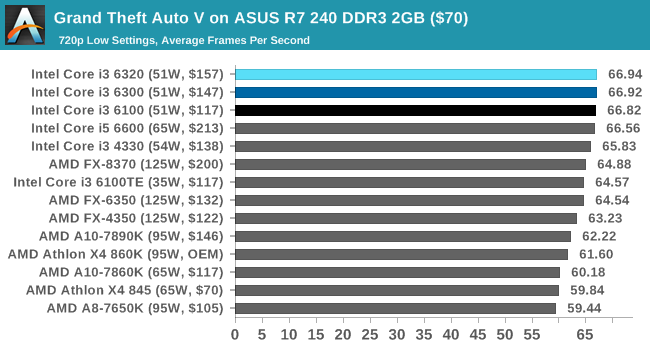
![Grand Theft Auto V on ASUS R7 240 DDR3 2GB ($70) [Under 60 FPS]](https://images.anandtech.com/graphs/graph10543/83079.png)
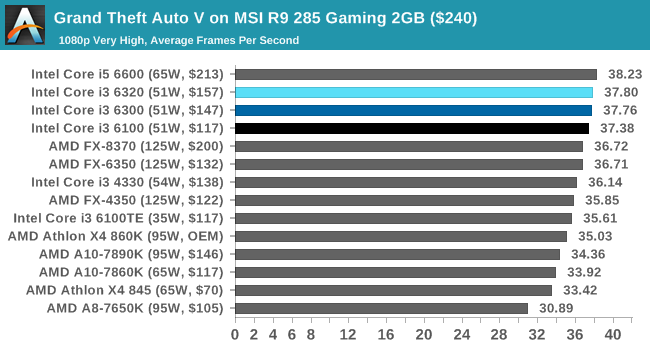
![Grand Theft Auto V on MSI R9 285 Gaming 2GB ($240) [Under 60 FPS]](https://images.anandtech.com/graphs/graph10543/83087.png)
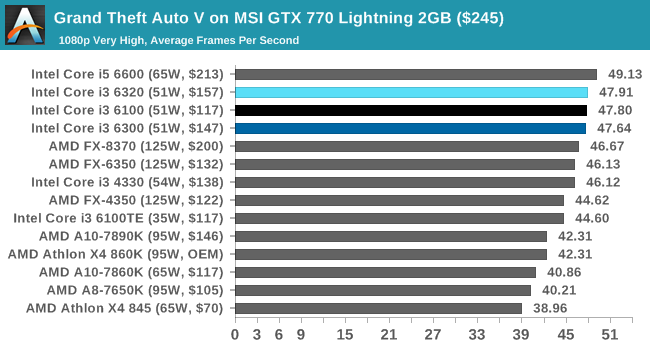
![Grand Theft Auto V on MSI GTX 770 Lightning 2GB ($245) [Under 60 FPS]](https://images.anandtech.com/graphs/graph10543/83095.png)
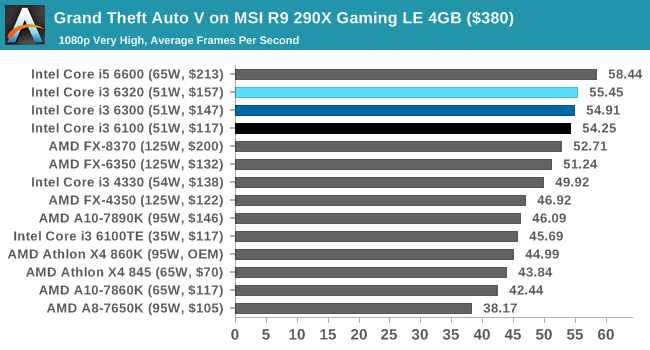
![Grand Theft Auto V on MSI R9 290X Gaming LE 4GB ($380) [Under 60 FPS]](https://images.anandtech.com/graphs/graph10543/83103.png)
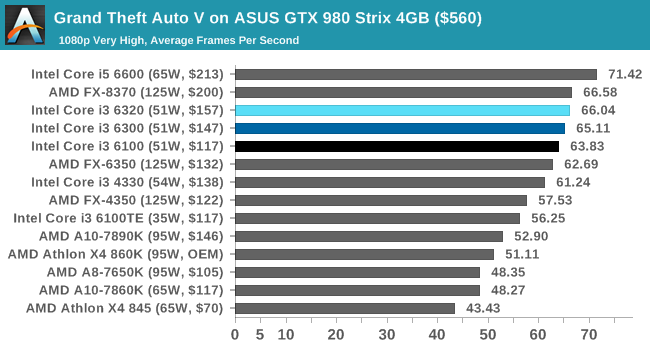
![Grand Theft Auto V on ASUS GTX 980 Strix 4GB ($560) [Under 60 FPS]](https://images.anandtech.com/graphs/graph10543/83113.png)
It's an onslaught of data, but clicking through to each graph will expand it in finer detail.
Again, with a discrete GPU, the Core i3s sit very pretty at the top of our graphs. In most cases, against similarly priced AMD CPUs, they can be from 5% to 20% quicker in average frame rates - the higher power the GPU, the more that it matters.
An interesting graph is the final one, with the GTX 980 and lookng at the percentage of frames over 16.6ms (i.e., the percentage time the game spends under 60 FPS). With the Core i3 parts, the game spends at least 50% of its time above 60 FPS running at 1080p Very High settings, however with similarly priced AMD APUs, this drops down to 15-25%. While running at V-Sync, this will be noticable. The FX CPUs get a better showing with the GTX 980, with the FX-6350 and the FX-8350 straddling the Core i3s for average frame rates and the 60 FPS metric.











94 Comments
View All Comments
Samus - Tuesday, August 9, 2016 - link
^This.I love WinRAR, but even a blind test will demonstrate 7zip to be faster, especially at compression. Decompression is often storage limited unless you have a good RAID or PCIe SSD.
plopke - Monday, August 8, 2016 - link
I bought a core i3 6300 for my parents but only paid the price of a i3 6100 around 109 euro, the price gap is so big for such a small performance increase some vendors decided just to dump them out of their inventory.ShieTar - Monday, August 8, 2016 - link
Nice review. Any chance that the Pentiums and maybe even Celerons will be added to the comparison?Everybody reviews the i5&i7, but it's really hard to get any feel on how fast (or slow) the very cheapest Intel CPUs really are.
fanofanand - Tuesday, August 9, 2016 - link
I second this, I see a lot of inexpensive devices running low-end Intel parts and it sure would be nice to see how they stack up.jaydee - Monday, August 8, 2016 - link
Any attempts at trying Quicksync with the Skylake i3?AndrewJacksonZA - Wednesday, August 10, 2016 - link
+1 on the Quicksync please.elbert - Monday, August 8, 2016 - link
The i3's should have been removed from the desktop line up a long time ago. Quad cores come out over 10 years ago and Intel is still trying to sale dual cores for the desktop. Its really a testament to how tight a hold Intel's monopoly is on the PC business. Currently the hold that is killing the PC business.DanNeely - Monday, August 8, 2016 - link
The persistence of dual core hardware says more about the failure of most software to benefit from larger numbers of cores. Unless you've got at least 3 big threads running in parallel the extra physical cores of the i5/7 only serve to drive up manufacturing costs and power consumption.FunBunny2 - Monday, August 8, 2016 - link
-- The persistence of dual core hardware says more about the failure of most software to benefit from larger numbers of cores.the number of embarrassingly parallel user space applications continues to be stuck at a couple.
Ratman6161 - Monday, August 8, 2016 - link
But, for all those that are just web surfing, reading email, and typing Word documents, how much parallelism do they need? A while back I refurbished a couple of Core 2 duo laptops from about 2009. Upgraded them from 2GB to 4BB of cheap ram and slapped an el-cheapo SSD in place of the old 5400 RPM disk drives and they felt like new machines. For the people doing the sorts of tasks I mentioned above, they are more than good enough - even an i3 is overkill for the task.